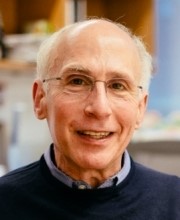The Medicine by Design Global Speaker Series invites established and emerging international leaders in regenerative medicine to engage with our extraordinary community of researchers and clinicians.
Medicine by Design, in partnership with the Ontario Institute for Regenerative Medicine, is pleased to welcome Lee Rubin, PhD, professor in the Department of Stem Cell and Regenerative Biology at Harvard University. This event will be webcast
Biography
 Lee Rubin received his PhD in Neuroscience from The Rockefeller University and completed postdoctoral fellowships in pharmacology at Harvard Medical School and in neurobiology at Stanford University School of Medicine. He has broad experience in both academia and industry, particularly in the realms of cell-based assays and drug discovery. Prior to Harvard, he was chief scientific officer of Curis, Inc., a Cambridge-based biotechnology company, where his group identified the first small molecule regulators of the hedgehog signalling pathway. One of their antagonists was developed by Genentech and is now (as Erivedge) approved as the first oral treatment for metastatic basal cell carcinoma. At Harvard, much of Rubin’s work is focused on finding key molecular mediators of different neurodegenerative diseases and on searching for effective pre-clinical therapeutic candidates. His group’s research takes advantage of their ability to produce large numbers of patient-derived induced pluripotent stem cell lines and of effective means of deriving large numbers of differentiated neurons from them. They have set up an array of techniques that allow them to identify early cellular and physiological changes in neurons as they become diseased. For example, they have identified new targets for the treatment of the motor neuron disorders spinal muscular atrophy and amyotrophic lateral sclerosis. They are also studying autism spectrum disorders, Parkinson’s disease and Alzheimer’s disease. Recently, his group discovered that a circulating protein, GDF11, has the ability to reverse some of the changes in the central nervous system associated with aging. They are actively exploring the therapeutic implications of these observations.
Lee Rubin received his PhD in Neuroscience from The Rockefeller University and completed postdoctoral fellowships in pharmacology at Harvard Medical School and in neurobiology at Stanford University School of Medicine. He has broad experience in both academia and industry, particularly in the realms of cell-based assays and drug discovery. Prior to Harvard, he was chief scientific officer of Curis, Inc., a Cambridge-based biotechnology company, where his group identified the first small molecule regulators of the hedgehog signalling pathway. One of their antagonists was developed by Genentech and is now (as Erivedge) approved as the first oral treatment for metastatic basal cell carcinoma. At Harvard, much of Rubin’s work is focused on finding key molecular mediators of different neurodegenerative diseases and on searching for effective pre-clinical therapeutic candidates. His group’s research takes advantage of their ability to produce large numbers of patient-derived induced pluripotent stem cell lines and of effective means of deriving large numbers of differentiated neurons from them. They have set up an array of techniques that allow them to identify early cellular and physiological changes in neurons as they become diseased. For example, they have identified new targets for the treatment of the motor neuron disorders spinal muscular atrophy and amyotrophic lateral sclerosis. They are also studying autism spectrum disorders, Parkinson’s disease and Alzheimer’s disease. Recently, his group discovered that a circulating protein, GDF11, has the ability to reverse some of the changes in the central nervous system associated with aging. They are actively exploring the therapeutic implications of these observations.

